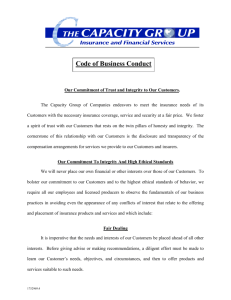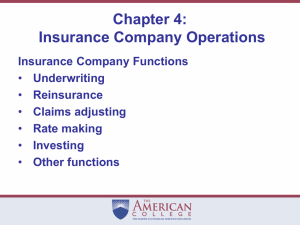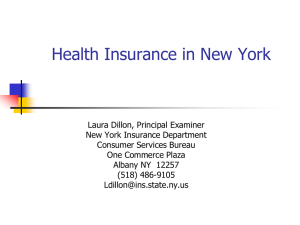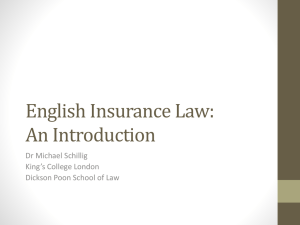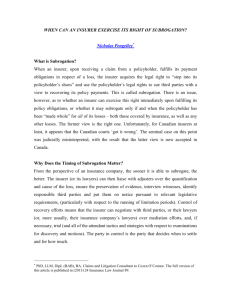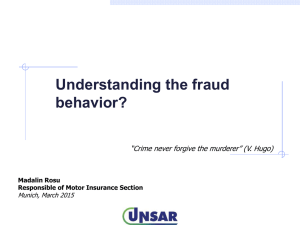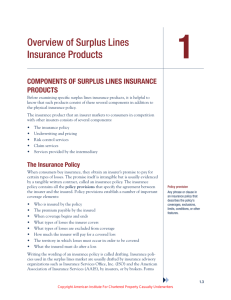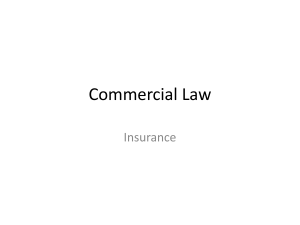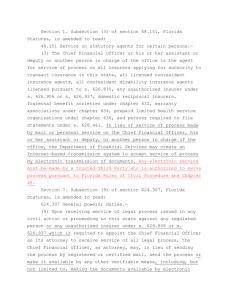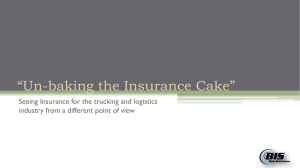Why is safety important for an insurer?
advertisement
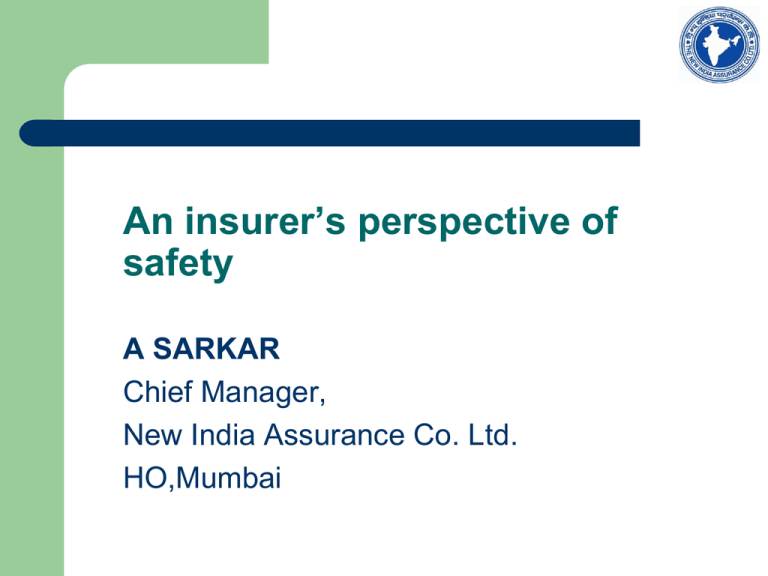
An insurer’s perspective of safety A SARKAR Chief Manager, New India Assurance Co. Ltd. HO,Mumbai Contents Risks covered by general insurers Why is safety important to an insurer? – – Safety for risk reduction Lack of adherence to safety–root cause of most accidents Adherence to safety – A ‘win-win’ for both insurer and insured General Insurers mainly cover the following risks Construction of infrastructure such as roads, bridges, ports, airports, buildings Storage cum erection for factories, refineries, power plants Marine cum storage cum erection (I.e. storage cum erection including transit both overseas and domestic) Advance loss of profit (followed by losses in above policies) Operational cover after testing and commissioning such as fire, flood, earthquake, machinery breakdown and Terrorism. Third party liability. Activities in any project involve Design of layouts, machines, and processes Procurement of goods/equipments Installation of all necessary equipment at site Testing of the completed installation Post takeover operation/maintenance Project insurance – Erection All Risk Local Supplier Fabricator Intermediate Storage Site Foreign supplier Port TRANSPORT MARINE (IMPORTS) MARINE (LOCAL) MARINE LOP INTERMEDIATE OFFSITE STORAGE ADDITIONAL TRANSIT CONSTRUCTION MCE EAR (SCE) CAR TPL CPM ALOP OPERATION FIRE FLOP MB BOILER MLOP EEI IAR MEGA Civil const. Storage Erection Testing Commn. Operational insurance - Industrial All Risk Policy •A single simplified, convenient, cost effective policy Fire Insurance Boiler insurance • Most Comprehensive coverage –Not a named perils policy Fire Loss of Profit Electronic equipment insurance Machinery Insurance MLOP Burglary insurance • depreciation not deducted in Machinery Breakdown total loss or partial loss claim •Underinsurance to the extent of 15% waived Contents Risks covered by general insurers Why is safety important to an insurer? – – Safety for risk reduction Lack of adherence to safety–root cause of most accidents Adherence to safety – A ‘win-win’ for both insurer and insured Why is safety important for an insurer? Safety is a part of risk management for reduction in risk before transferring to insurance company Risk Management Risk Identification Risk Evaluation Risk Reduction Risk Transfer Safety Insurer Even though insurers come into the picture after the risk has been transferred, still adherence to safety norms is essential from the point of view of the insurer as well, because most accidents are a result of not abiding by safety norms Of course, insurance companies offer discount on premium if during preacceptance it is established that safety norms are being followed Contents Risks covered by general insurers Why is safety important to an insurer? – – Safety for risk reduction Lack of adherence to safety–root cause of most accidents Adherence to safety – A ‘win-win’ for both insurer and insured Insurance company expects claims from Losses arising due to Fire, Lightning, Explosion, Riot & Strike and Malicious Damage, Damage by Terrorist activities, Impact Damage. Storm, Tempest, Cyclone, Flood, Inundation Rockslide, Landslide, Subsidence, Earthquake and Similar Natural Hazards. Electrical/Mechanical Breakdown, Failure of Control Systems Human Error, Negligence, Lack of Skill, Faults in Erection and Error in Handling Insurance company expects claims from Losses arising due to Burglary, Theft, Pilferage. Design Defect, Consequences of Faulty Material, Workmanship other than faulty erection Loss of revenue / Payment of Penalties - due to delay in commissioning. Accident / Sinking of Vessel, non Delivery, Shortage, Damage during Transit, Loading, Unloading Or any other accidental causes Fire losses – key reasons Fire mostly occurred in storage areas Fire mostly occurred in unattended areas or during unattended periods Not much importance is paid to fire protection in storage areas Inadequate training for fire emergencies No attempt to learn from past mistakes Lack of awareness of safety and following safety norms Fire losses – key causes & safety measures 23% 18% Key causes of fire 10% 7% 7% Must be No as per ISI smoking Proper lubrication Away from combustible Spontaneous ignition Burner flames Hot surface Overheated materials Friction Smoking 4% Electrical Safety measure 8% Purged or Proper inert stacking condition Loss prevention measures for ‘safety’ - Fire Conduction Radiation Convection Loss prevention measures for ‘safety’ - Fire Concept of passive fire protection Compartmentation Segregation Loss prevention measures for ‘safety’ - Fire Concept of passive fire protection Perfect Party walls Fire proof doors Loss prevention measures for ‘safety’ - Fire Concept of passive fire protection Encasing Separating distances Loss prevention measures for ‘safety’ - Transit Case study Collapse of bridge during crossing of 128 wheeler trailer carrying generator turbine River in spate, turbine lying in the middle of the river bed Cause of loss Classic case of Bridge Structural capacity imbalance One bridge span larger than the total length of 128-wheeler trailer Complete Loaded Trailer Weight came onto one bridge span Loss prevention – safety measures Route survey – roads/ bridges Loss prevention measures for ‘safety’ - Erection Case study Shifting of heavy silos in progress at a project site Crawler crane in operation collapses Heavy impact damage to silos, crane & equipment stored underneath Cause of loss Uneven ground conditions Crane encountered a quickly filled soft ground spot Loss prevention – safety measures Check ground under base of crane Loss prevention measures for ‘safety’ - Process Case study Un-confined vapor cloud explosion from leakage of hydrocarbons Cause of loss Pipeline (250mm dia. and 35 bar press.) failed at sleeper-type pipe support. Small release continued from bottom of pipe for 1 hour after detection. Refinery was put into crash shutdown & water curtains set up. Full bore rupture following pressure surge when pipeline valve closed by staff, without stopping supply pumps. External corrosion and internal pitting evident Normal pipe wall thickness = 7mm. Corroded section = < 1mm thick. Loss prevention measures for ‘safety’ - Process Loss prevention measures for ‘safety’ – Other perils Losses Some examples of prevention measures for arising out of safety Earthquake & similar natural hazards Storm, tempest, cyclone, flood Design and construction of building to withstand the shock of earthquake Ensure that boxes in warehouse are stacked wide rather than high and secured in groups with ropes or strapping Place materials especially large components far enough apart to avoid their damaging one another when toppling over Design building to withstand highest wind speeds recorded in 25 year period Pay attention to weather forecast regularly and alert emergency team/ fire brigade in case of sever weather forecast Loss prevention measures for ‘safety’ – Other perils Losses Examples of prevention measures for safety arising out of Water damage Theft, pilferage Level of storage yard to be 0.5m above highest level of river for the last 25 years Constructing rain water drainage system for highest rainfall in the last 25 years Factory should be surrounded by compound wall with entry possible only with identity proof through guarded gate Contents Risks covered by general insurers Why is safety important to an insurer? – – Safety for risk reduction Lack of adherence to safety–root cause of most accidents Adherence to safety – A ‘win-win’ for both insurer and insured A ‘win-win’ for both insurer and insured Awareness of safety among all Implementation of safety processes Reduction of claims to insurance companies Increase in surplus of the insurance companies Building up of good reserves and increased capacity of insurance companies Insurance companies can provide wider cover at a lower premium without re-insurer support Thank you

